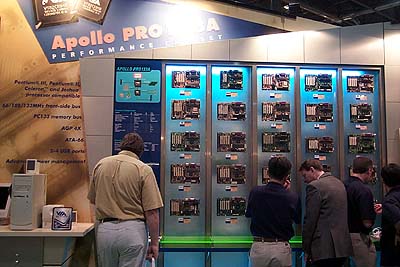Motherboards in 2000 Preview - Part 1: Chipsets
by Anand Lal Shimpi on December 6, 1999 12:44 AM EST- Posted in
- Motherboards
VIA to the rescue
 VIA
will have a very strong year in 2000 as they have quite a few promising products
scheduled for release.
VIA
will have a very strong year in 2000 as they have quite a few promising products
scheduled for release.
One product which doesn't fit that category because it already has been released is the Apollo Pro 133A. With the i820 being out of the price range of many and the performance with SDRAM being less than desirable, the Apollo Pro 133A is left as the only chipset that offers support for the 133MHz FSB, Ultra ATA 66, and AGP 4X specifications. For those that absolutely must have one of the 133MHz FSB Pentium IIIs, the Apollo Pro 133A is a much more cost effective option than the i820/Rambus and a higher performing option than the i820 + MTH + SDRAM.
Quite a few manufacturers have been talking about their Apollo Pro 133A products, but we will finally see 133A based motherboards shipping in good quantities next year. A very attractive point about the 133A chipset is its cost, which should help keep boards based on the chipset well below the $159 mark of 820 based boards. Expect to see most 133A boards fall within the $100 - $120 range - not bad at all for a board that claims support for the 133MHz FSB, Ultra ATA 66, and AGP 4X specifications.
A fact we recently learned about VIA's North Bridges, including the 694X of the Apollo Pro 133A from above, is that they include built-in SMP support. While it is true that the BX chipset also supports SMP, it requires the use of an additional ASIC in order to take advantage of SMP. The 694X North Bridge, on the other hand, does not. If you couple the features we just discussed that the Apollo Pro 133A supports along with the low-cost of the chipset, a dual Apollo Pro 133A board could become a very affordable entry level path into the world of multiprocessing.
We weren't the only ones to think about this possibility as we managed to catch at least one demo of a dual Apollo Pro 133A based Pentium III system, so you can expect to see dual Apollo Pro 133A boards surface sometime in the first half of 2000. Stability issues are what is keeping manufacturers from releasing dual 133A boards right now. As you can probably guess on your own, making a dual processor board a stable one takes a considerably greater effort than toying with a single CPU board and thus very few manufacturers are up to the job. When these boards do hit the market, expect them to retail for no more than $130. For a dual processor board, that isn't bad at all.










0 Comments
View All Comments